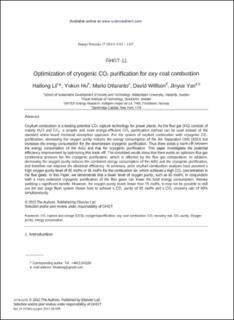| dc.contributor.author | Li, Hailong | |
| dc.contributor.author | Hu, Yukun | |
| dc.contributor.author | Ditaranto, Mario | |
| dc.contributor.author | Willson, David | |
| dc.contributor.author | Yan, Jinyue | |
| dc.date.accessioned | 2020-04-02T12:38:44Z | |
| dc.date.available | 2020-04-02T12:38:44Z | |
| dc.date.created | 2013-08-12T11:23:01Z | |
| dc.date.issued | 2013 | |
| dc.identifier.citation | Energy Procedia. 2013, 37 1341-1347. | en_US |
| dc.identifier.issn | 1876-6102 | |
| dc.identifier.uri | https://hdl.handle.net/11250/2650108 | |
| dc.description.abstract | Oxyfuel combustion is a leading potential CO2 capture technology for power plants. As the flue gas (FG) consists of mainly H2O and CO2, a simpler and more energy-efficient CO2 purification method can be used instead of the standard amine-based chemical absorption approach. For the system of oxyfuel combustion with cryogenic CO2 purification, decreasing the oxygen purity reduces the energy consumption of the Air Separation Unit (ASU) but increases the energy consumption for the downstream cryogenic purification. Thus there exists a trade-off between the energy consumption of the ASU and that for cryogenic purification. This paper investigates the potential efficiency improvement by optimizing this trade-off. The simulated results show that there exists an optimum flue gas condensing pressure for the cryogenic purification, which is affected by the flue gas composition. In addition, decreasing the oxygen purity reduces the combined energy consumption of the ASU and the cryogenic purification, and therefore can improve the electrical efficiency. In summary, prior oxyfuel combustion analyses have assumed a high oxygen purity level of 95 mol% or 99 mol% for the combustion air, which achieves a high CO2 concentration in the flue gases. In this Paper, we demonstrate that a lower level of oxygen purity, such as 80 mol%, in conjunction with a more extensive cryogenic purification of the flue gases can lower the total energy consumption, thereby yielding a significant benefit. However, for oxygen purity levels lower than 75 mol%, it may not be possible to still use the two-stage flash system shown here to achieve a CO2 purity of 95 mol% and a CO2 recovery rate of 90% simultaneously | en_US |
| dc.language.iso | eng | en_US |
| dc.rights | Attribution-NonCommercial-NoDerivatives 4.0 Internasjonal | * |
| dc.rights.uri | http://creativecommons.org/licenses/by-nc-nd/4.0/deed.no | * |
| dc.subject | CO2 capture and storage (CCS) | en_US |
| dc.subject | cryogenicpurification | en_US |
| dc.subject | oxy-coal combustion | en_US |
| dc.subject | CO2 recovery rate | en_US |
| dc.subject | CO2 purity | en_US |
| dc.subject | Oxygen purity | en_US |
| dc.subject | energy consumption | en_US |
| dc.title | Optimization of Cryogenic CO2 Purification for Oxy-coal Combustion | en_US |
| dc.type | Peer reviewed | en_US |
| dc.type | Journal article | en_US |
| dc.description.version | publishedVersion | en_US |
| dc.rights.holder | The Authors | en_US |
| dc.source.pagenumber | 1341-1347 | en_US |
| dc.source.volume | 37 | en_US |
| dc.source.journal | Energy Procedia | en_US |
| dc.identifier.doi | 10.1016/j.egypro.2013.06.009 | |
| dc.identifier.cristin | 1042571 | |
| dc.relation.project | Norges forskningsråd: 193816 | en_US |
| cristin.unitcode | 7548,70,0,0 | |
| cristin.unitname | Termisk energi | |
| cristin.ispublished | true | |
| cristin.fulltext | original | |
| cristin.qualitycode | 1 | |

